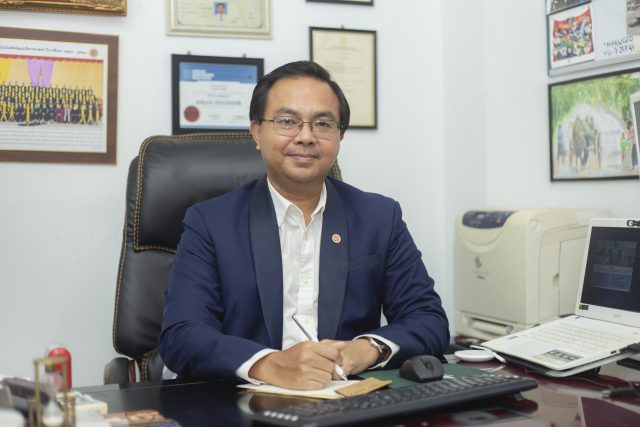1. Tell us about Mandalay Technology story.
MT started from the introduction of GIS/Remote Sensing technologies into Myanmar. GIS refers to the Geographical Information System (essentially digital mapping using satellite technology) whereas Remote Sensing is the acquisition of information about an object or phenomenon without making physical contact with the object, in contrast to on-site observation. It can be used in agriculture, in determining how many acres of corn, sugarcane or even poppy plantations we have in the country, to map out waterways, in city planning, etc. Now the technology has moved on to a Geo Spacial Technology. Now we are in the space of IT and Communications Solutions, Electricity and Energy, Science, Technology and Engineering Education Solutions as well. We even venture into engineering design solutions as well as construction management.
Whatever area we venture, our mission is still relevant: Technologies for Development. From 1998 till now, it is still a technology company. It started as a branch/subsidiary of a US company, Intergraph. After a series of external changes from the parent entity, I bought the local company in 2008 and changed its name to MT.
2. How does it gel with your previous working experiences in places like the World Bank?
I have worked as a consultant (short term) in the WB headquarters in Washington DC. I studied international development in the US and due to this interest in learning the workings of organizations such as WB and IMF, I ended up working there. I worked in the division of Global Information Communication Technology (GICT) which served both the operations of the IMF and the WB. The division supported the development of GICT in both public and private sectors in developing countries. I had great experience from the donor side supporting developing countries such as Nepal, Bhutan, etc., very similar to Myanmar. From that experience, I have opportunity share to Myanmar government, how to co-operate with these two organizations to create the most effective solutions for development of the country.
I came back from US in 2009, just a year prior to the first democratic government led by President U Thein Sein took power. One of the first tasks that the government had tried to accomplish at that time was to formalize relations with the international community, including international organizations such as IMF and WB. The President office contacted me to find out the requirements to get reconnected back to WB and to provide advice on the conditions and the process.
We all agree that the participation of these international organizations would give much needed momentum to the country development. In addition to the above, I have also participated myself or through MT, many development projects of these organizations. All these would not have been possible without my work experience there.
3. What are your highest revenue drivers? Which segment of your business derives the highest revenues?
When we started, we started with GIS sensing systems. The users of these systems are mainly government ministries and departments e.g., YCDC, MCDC, Ministry of Construction, Ministry of Agriculture, Department of Irrigation, Ministry of Forestry, MOGE, Ministry of Rail, etc. Even till now, the majority of our customers (80%) are governmental organizations. Now-a-days, since we have ventured into more businesses, our customer based is now more widespread, including even universities and colleges.
We also participated in international projects and as such, it is not possible to determine which segment in particular consistently delivers a high revenue percentage. It changes from year to year. E.g., When MT first started and when GIS was first introduced into Myanmar, most of the revenues are from there. During the past year, when we sell our education solutions products to colleges and universities, most of our revenues from the sale of these products. Hence revenues per segments depends on the timing horizon that we are talking about. We even formed an technology innovation unit last year to take advantage of the technology and market trends happening within the country.
4. What are the critical success factors of a technology business, esp., in Myanmar?
When it comes to success to a technology related business in Myanmar, the first important factor is passion. You need passion to stay committed to the business. You need to have the belief that you are doing this not just to put the food on the table, but to help the people and the country through your business. Technologies for Development!
The second point is you must have patience. Once you aim high and in order to achieve that high aim, you need time (patience) in addition to commitment and passion. Especially if you are dealing with new technology and its application which are not in widespread use, you need to bring the students, teachers, businesses and government along. You need to educate them patiently. Train them many many times. You need to take the risk that your patience may not bear fruit and trust that all efforts will one day materialize into something much more satisfying.
The last P is persistence. Only when you persist in the pursuit of excellence in your technological field that you are committed to, then people will trust you. We have been doing that. Anyone trying out or using GIS technology would have heard of us. Now, we are also well known in universities and colleges as suppliers of science and engineering education solutions products. We do not reach this point in one or two years. We have done GIS for twenty years and we have provided education solution products for over ten years. Only when you are that persistent, the market with reward you with a share of the pie.
5. How has the COVID and the change of government affected your business so far?
Both are really disheartening to us. Even businesses that are many times bigger than us and even the projects many times sizable than what we used to do, they have either slowed down significantly or totally stopped. Last week I was in Pathein (Ayeyawaddy Region) and I visited both Pathein Industrial City (PIC) and Ayeyawaddy International Industrial Port (AIIP). They are like dead towns. No activities whatsoever.
We are also part of the crowd. Our business also slowed down. We are all down, but we cannot stay down. We have core values: people, innovation, sustainability. Simple … our people must innovate to continue to sustain our business.
Here I want to mention something of importance: political colors. If you ask me if we have political colors, I would have to say yes. Instead of fighting among the colors, the colors that we all should be having is the one for the development of the country. You may like whatever political affiliation yet, once you are in this business, you use the technology available to us, to make our nation developed and successful.
I suspect that when COVID is over and when the Armed Forces eventually formed a New Democratic government, at least 50% of the existing business would no longer be around! The key message is we cannot be among the dead 50%. That’s why we all must participate in the continued development of the nation at this very point of time.
At the same time, I would like to highlight that as responsible businesses, despite the downtown, we need to continue to help those in need. We actually did a lot of charity work, via the people to people sharing network. It a charitable organization led by us. We donated lots of daily necessities to tens of thousands of side car drivers (tok tok) during the first wave of COVID. During the second wave, we also have helped the poor families in suburban neighborhoods through donation of staple food items. In the third wave, we also provided medical and food necessities to those in need.
Especially at the times, where the extremist organizations such as PDF are carried out attacks and the people at the nations are at different ends of ideology, we need to focus on filling in the blanks for those in need and helping the nation on areas of needs.
6. What are your future plans?
I believe we would still be following our mission: Technologies for development, and working in line with our core values. We as a country, need to focus on Human Resources development and capacity building. Natural resources would only sustain us for a limited time.
Even the PhD degree that I have done for six years from 2012 – 2018, the speciality was in Human Resources Development in a nation. Education and development of people is the key. So I would be focusing on this in the future.
In addition, the Industry 4.0 is also here in Myanmar. In order to accommodate this, we have management 4.0, technology 4.0, education 4.0 and even media 4.0. All these need people development across all levels. Either in my own personal capacity or with my company, I would be focusing on people development and innovation.
7. Compared to 2019 and prior, how has your business performed in 2020 and 2021?
Compared to 2019, we are facing a double whammy of COVID together with political uncertainty. We have so far not reduced the number of employees yet, but we have lowered the salaries of all our staff. We are having many off work days, holidays and work from home, which all effect our productivities and efficiencies. The business operations also have to be halted for many months. Everything is not back to normal yet.
Reductions in either manpower or pay is inevitable for every business during this time. Having said that, we need to focus on the use of technology to allow us excel in businesses that are probably doing better than 2019 due to COVID and stay home directives. E.g., home food delivery companies such as food panda, or grab are in fact utilizing technology to even do better than before.
If we can continue to find gaps in fulfillment of people needs and if we can successfully focus and operate in that niche, we would continue to survive and do well.
In summary, compared to 2019, we have slowed down, but have not stopped. We are struggling yet continuing to find ways to sustainable operations.
8. What would be your one suggestion to get Myanmar economy quickly back to normal?
It’s a difficult question. The most important is politics. Political changes has enormous impacts on businesses and society. We cannot continue to have political instability and be prosperous at the same time. As such I pray we reach that state soonest possible.
9. If you can affect one change in government policy, what would it be?
We need to have a government that is accepted by international community as well as by the people. Without one, regardless of how good the policies are, they would fail at the implementation level.
People and government must trust each other and must believe in each other. Only then, we would have successful implementation of policies that help the nation.
10. Which industry segments would be growing best in Myanmar in the next three years?
In Myanmar, we can never ignore agriculture, livestock and fishery sectors. Two third of our population is in these sectors. Continued growth in these sectors would uplift the GDP and the poor out of poverty. But we have to realized these three sectors that employ two third of our population only contributes one third of our GDP. Unless that share increases, we would not be making effective use of our Human Resources.
In developed countries, big farms that generate big revenues are run only by a few people. In Myanmar, we are using manual labor too much. We have close to fifty people who just carry bags of rice at local rice mills. We need to use technology to upgrade and at the same time value add. The whole world is facing food security issue and we should take advantage of that need by creating value added agri products, instead of just exporting raw items.
The next growth sector would be education. We need more technical education institutes and with good education background, families can grow and prosper.
The third growth sector would be technology based professional services. As we have more and more technology based businesses, the support services would start utilizing technology to support them and this sector would continue to grow.
The last sector is the production sector. In order to be rich, we need to be making or producing something. Just look at China. Our manufacturing sector is still in infancy and we still have much to grow. With the wages in China and neighboring countries growing, we should make use of our competitive advantage (of still having relatively low wages) to move up to the next level of economic growth.










